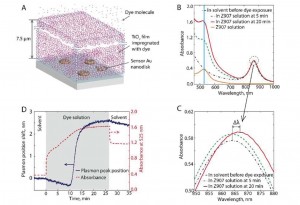Researchers led by Professor Christoph Langhammer have developed a novel tool based on indirect nanoplasmonic sensing for in situ studies of dye-sensitized solar cells (DSSCs). Their work elucidates the kinetics of dye impregnation into mesoporous TiO2, known to be a critical step in fabrication of DSSCs and therefore important for scale-up of DSSCs.
DSSCs offer a potentially low-cost, aesthetically appealing alternative to conventional silicon based technologies. The key components of a cell are a TiO2 film filled with a densely packed monolayer of photon absorbing dye molecules and an electrolyte. Mechanism-oriented tools and studies are needed to understand how to reproducibly form an optimal dye monolayer on the TiO2 and how to make the DSSC fabrication process compatible with industrial demands. Langhammer’s group has done exactly that by using a new method to follow the dye impregnation process in detail.
The researchers use Hidden Interface-Indirect Nanoplasmonic Sensing (HI-INPS), a technique that uses the localized surface plasmon resonance of Au nanoparticles (coated with a thin dielectric layer). When illuminated with near-visible light, their sensitivity to dielectric changes. This sensitivity is short- ranged, typically within 50–100 nm from the sensor particle surface. Therefore if a thick layer of material, like mesoporous TiO2, is deposited onto such a sensor chip, the plasmonic Au sensor particles probe the hidden interface region between the sensor chip surface and the sample material. HI-INPS is a neat way to monitor the dye molecule adsorption without disturbing the DSSC.

Read the paper here:
Diffusion and adsorption of dye molecules in mesoporous TiO2 photoelectrodes studied by indirect nanoplasmonic sensing
Viktoria Gusak, Leo-Philipp Heiniger, Vladimir P. Zhdanov, Michael Grätzel, Bengt Kasemo and Christoph Langhammer
DOI: 10.1039/C3EE42352B
By Prineha Narang










